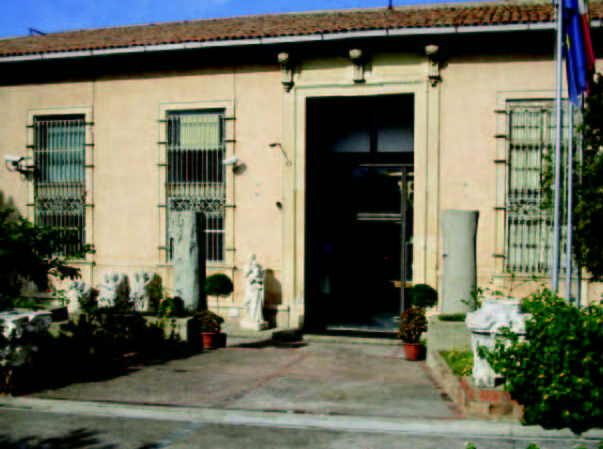

museo civico regionale Matteo
Calabrò |
 |
Il
Museo Regionale di Messina, ospitato dal 1914 negli ambienti di una ex
filanda, ha vissuto nel tempo varie trasformazioni e si presenta tuttora
come una realtà in fieri, in attesa del prossimo trasferimento
nella nuova e più ampia sede adiacente. La raccolta, costituita
intorno al nucleo centrale di opere provenienti dall’ottocentesco
Museo Civico di Messina e alimentata dalla congerie di reperti recuperati
dopo il devastante sisma del 1908, rimane la più completa (per
quanto frammentaria) |
The Museo Regionale di Messina, which has been hosted since 1914
in the building of a former spinning mill, witnessed several transformations
throughout time and still appears as a reality in progress, awaiting the
forthcoming transfer into the new, broader adjacent seat. The collection,
established around the core of works coming from the 19th century’s
Museo Civico di Messina and supplied by the mass of finds recovered
after the devastating earthquake of 1908, remains the most complete (even
though fragmentary) documentation of the complex stratified cultural events Stefania Lanuzza |
|
MUSEO
CIVICO REGIONALE Viale della Libertà 465 98121 Messina, Italy tel. +39 090 361292/3 www.regione.sicilia.it/beni culturali |
 |
Girolamo
Alibrandi, Presentazione al Tempio, 1519 |
Realizzato per l’altare maggiore della chiesa della Candelora e successivamente trasferito nella chiesa di San Nicolò dei Gentiluomini, il dipinto è entrato a far parte delle collezioni del Museo in seguito al terremoto del 1908, ridotto in oltre trecento frammenti. Celebrato da tutte le fonti come il capolavoro assoluto dell’Alibrandi, diversi e complessi sono i riferimenti culturali che è possibile rintracciare in esso, dagli echi della pittura antonellesca all’evidente influenza di Cesare da Sesto, di Raffaello (non a caso l’Alibrandi era soprannominato dai contemporanei il “Raffaello di Messina”) e Sebastiano del Piombo, insieme all’assimilazione della pittura nordica, come lasciano chiaramente intendere l’attenzione riservata agli elementi naturalistici e il segno limpidissimo.
Carried out for the high altar of the Candelora church and then transferred
into the church of San Nicolò dei Gentiluomini, the painting
became part of the Museum collections after the earthquake of 1908, which
reduced it into more than three-hundred fragments. Celebrated by all the
sources as Alibrandi’s absolute masterpiece, several complex cultural
references can be traced in it, from echoes of Antonello da Messina’s
painting to the evident influence of Cesare da Sesto, of Raffaello Giampaolo Chillè |
| Matteo
Calabrò Né en / Born in 1978 Il vit et travaille a / He lives and works in Lyon fabtchang@hotmail.com |
Il
Miracolo dell’Uccello, 2004 |
L’installazione
di Matteo Calabrò tende ad esprimere, in maniera sintetica e quasi
simbolica, il fascino esercitato sull’autore da uno dei più
interessanti dipinti del Museo Regionale di Messina: la Presentazione
al Tempio di Girolamo Alibrandi. L’opera contemporanea si sovrappone
a quella antica tentando con questa un dialogo che si traduce sul piano
formale in una sorta di incontro-scontro, il cui risultato rimane libero
a interpretazioni diverse che vanno al di là del puro fatto visivo.
Matteo Calabrò’s installation tends
to express –synthetically and almost symbolically– the charm
exerted on him by one of the most interesting paintings in the Regional
Museum of Messina: the Presentazione al Tempio by Girolamo Alibrandi.
The contemporary work overlaps the ancient one attempting a dialogue with
the latter which translates into a sort of an encounter/quarrel whose
result is free for different interpretations which go beyond the mere
visual fact. Giampaolo
Chillè |
|
 |
Argentiere
messinese, Manta |
L’opera fa parte di un’interessante serie di mante in argento, esposte nelle sale del Museo Regionale, realizzate per impreziosire antiche immagini religiose destinate alla devozione, secondo un uso che vanta a Messina un’antica tradizione e che trova nella celebre manta d’oro della Madonna della Lettera, eseguita da Innocenzo Mangani (1668), l’esempio più significativo. Inserita entro una ricca cornice di legno dorato e intagliato rappresenta la Madonna della Catena. Illeggibili sono oggi i volti della Vergine e del Bambino, dipinti su un fondo di rame dorato lievemente rabescato. Impresso sull’opera è il marchio dell’argentiere Michele Rizo o Riso, la cui attività è documentata a Messina e in provincia nella seconda metà del XVII secolo. Impossibile è, allo stato attuale degli studi, precisare se egli abbia punzonato l’opera in qualità d’artefice o di console saggiatore. The work is part of an interesting series of silver artworks, exposed in the halls of the Regional Museum, which have been carried out to embellish ancient religious images destined to devotion, in compliance with a practice which boasts an ancient tradition in Messina and whose most significant example is the renowned golden image of the Madonna della Lettera (Our Lady of the Letter), carried out by Innocenzo Mangani (1668). Surrounded by a rich gold-plated, carved wood, it represents the Madonna della Catena (Our Lady of the Chain). The faces of the Virgin and Infant Jesus, painted on a background of golden, lightly arabesque copper, are nowadays undecipherable. The work is engraved with the mark of silversmith Michele Rizo or Riso, whose activity is documented in Messina and throughout the province in the second half of the 17th century. It cannot be ascertained in the current status of the studies whether he punched the work as author or assayer consul. Giampaolo Chillè |
I Coniugi in Silenzio Salvatore
Raimondo Daniela
Milone |
Manta
da luna park, 2004 |
L’istallazione,
il cui titolo risulta mutuato da una geniale autobiografia di Carmelo
Bene edita nel
The
installation (whose title is borrowed from a brilliant autobiography of
Carmelo Bene, published in 1983) seems to fully express of the value given
to appearance in the contemporary world, as well as its mystifying power.
Coated and disguised, variously inflated, touched up by scalpel and silicone,
reality exceeds the most lively fantasy every day, thus going beyond the
limits of possibilism and paradox and celebrating the absurd craving to
be the absolute protagonist of those who believe that “being”
is nothing but an auxiliary verb. Giampaolo
Chillè |
|